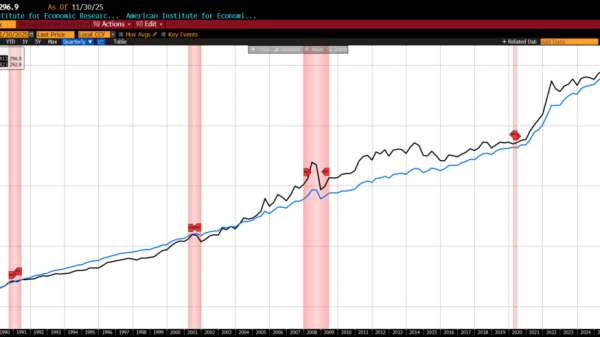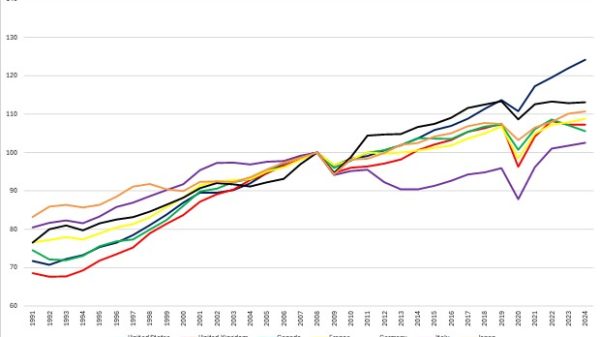President Trump last week ended trade talks with Canada because of an advertisement sponsored by the Ontario government featuring snippets of a 1987 speech Ronald Reagan gave, explaining the dangers of protectionism. The point of the advert was clear: protectionism hurts everyone, including the country imposing the protectionist policies. In response, the Ronald Reagan Presidential Foundation & Institute has said that “the ad misrepresents the Presidential Radio Address, and the Government of Ontario did not seek, nor receive, permission to use and edit the remarks.”
While it is presumably true that the Government of Ontario neither sought nor received permission to use and edit the remarks, the question of whether Reagan’s general view of tariffs and trade was misrepresented isn’t really open for debate. No, the ad uses Reagan’s own words to beautifully capture his principled support for free trade and exchange. Reagan would have approved the overarching message of the ad, even if we must agree with the Foundation that it does strip out some of the nuance and context of his April 25, 1987 “Radio Address to the Nation on Free and Fair Trade.”
As Reagan emphasized in his address, he supported free trade, advocating for bilateral reductions in trade restrictions where he could and unilateral reductions where he could not. It is true that under his watch, and to a great extent at his discretion, the US did impose tariffs and other trade restrictions. This has caused scholars like Sheldon Richman, then at the Cato Institute, to refer to Reagan as “the most protectionist president since Herbert Hoover,” Victor Davis Hanson, in 2017 to characterize the actions of President Trump during his first term as “a return to, or a refinement of, Reagan’s and the elder Bush’s principled realism: the acceptance that the United States has to protect its friends and deter its enemies,” and New Right thinkers like Oren Cass to claim Reagan as a “trade protectionist” who “basically started a trade war with Japan,” holding him up as a paragon of “trade restrictions done right.”
In doing so, however, these scholars reveal that they have fundamentally missed the forest for the trees. Ironically, they are the ones misrepresenting Reagan’s thoughts on international trade, not the Canadians.
To understand why, we need to appreciate the context within which Reagan took office in 1981. The US economy was in a deep economic downturn, with high inflation, rising interest rates, and an overall weak economy still trying to recover from the 1980 recession. If there was any industry that was hurt the most by this, it was the American car industry and its union workers, who were hurt not just by the recession, but by the arrival of cheaper, more fuel-efficient, and higher quality Japanese cars.
Faced with mounting pressures not just from the domestic automakers and their unions, but also a protectionist (and Democrat) Congress poised to enact sweeping protectionist legislation, Reagan had a difficult choice before him. In his autobiography, he writes, “Although I intended to veto any bill Congress might pass imposing quotas on Japanese cars, I realized the problem wouldn’t go away even if I did.” “The problem” Reagan referred to here was not “Japanese imported cars.” It was the demand for protectionist measures from Congress and the union autoworkers.
Reagan understood that vetoing any protectionist bills that Congress sent him would only forestall the inevitable and use up valuable political capital in the process. He understood, however, that he needed to do something, so he established the Auto Task Force. At a meeting, Vice President George H.W. Bush reportedly said, “We’re all for free enterprise, but would any of us find fault if Japan announced without any request from us that they were going to voluntarily reduce their export of autos to America?” Thus, the idea of voluntary export restraint was born. Reagan dispatched his trade representative, Bill Brock, to help with discussions.
This led to a meeting in the Oval Office on March 24th, 1981 with the Japanese foreign minister, where, in Reagan’s words, “I told him that our Republican administration firmly opposed import quotas but that strong sentiment was building in Congress among Democrats to impose them. ‘I don’t know if I’ll be able to stop them,’ I said. ‘But I think if you voluntarily set a limit on your automobile exports to this country, it would probably head off the bills pending in Congress and there wouldn’t be any mandatory quotas.’” In a statement given by then-Vice President Bush on April 8, 1981, he said that the White House is not “suggesting to the Japanese what they should voluntarily do” and that “[The administration wants] to avoid starting down that slippery slope of protectionism.”
In the end, Japan agreed to voluntarily restrict their exports to the United States, initially for a period of three years, though this was extended several times before finally being lifted in 1994.
One might argue that what Reagan was really doing was strong-arming Japan into reducing their exports by threatening the country with something worse if it did not comply. This is revisionist history at its finest. Reagan understood that choice is between actual options, not imagined ones. By preventing Congress from passing a protectionist import quota, Reagan had deliberately chosen the least protectionist option of the actual options before him, as David Henderson (a member of Reagan’s Council of Economic Advisors) notes. Reagan was committed not to protectionism, but to preventing protectionism precisely because, as he notes in his now-even-more-famous Radio Address, “over the long run such trade barriers hurt every American worker and consumer.”
Another example is Reagan’s 1987 imposition of tariffs to stop the Japanese from dumping semiconductors into the US market, which was the occasion of the radio address that the Canadian advertisement drew from. But even in this instance, Reagan attempted to use tariffs as a scaffold, not as a sledgehammer. Reagan accused Japan of violating their agreement in the US-Japan semiconductor trade agreement and placed a 100 percent tariff on specific goods to limit the adverse effects on American consumers. These targeted tariffs were used as a last resort, aimed at forcing compliance with an existing trade deal. As they started to have their intended effect, Reagan was able to reduce them, first in June of 1987 (two months after they were imposed) and then again in November (six months after they were imposed); they were eliminated entirely in 1991. Still, the tariffs harmed US consumers and did little to improve US industrial competitiveness. The use of tariffs to force a country to honor its previous obligations was a dangerous tactic, and Reagan was deeply aware of the consequences if the Japanese responded in kind. The fortieth president understood that trade wars hurt everyone involved and free trade was the ideal. The trade principles and policies of President Trump — easily the most protectionist president since Herbert Hoover — couldn’t be further from Reagan’s. Trump is imposing massive and sweeping tariffs on our allies, whereas Reagan bemoaned targeted tariffs to force compliance with an existing trade deal.
We can debate whether Reagan compromised his principles when he supported measures like voluntary export restraints or semiconductor tariffs. But we cannot honestly debate what those principles were. As Reagan himself said, “imposing such tariffs or trade barriers and restrictions of any kind are steps [he is] loath to take.”
Reagan was a free-trade advocate through and through. As America revisits trade policy in 2025, we should remember his true legacy — using every tool available to preserve and expand free trade, not to abandon it.

























